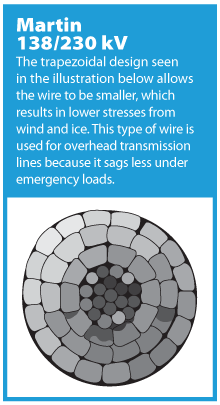Transmission & Distribution
Transmission and distribution refers to the different stages of carrying electricity over poles and wires from generators to a home or a business. The primary distinction between the two is the voltage level at which electricity moves in each stage.
After electricity has been generated, a system of electrical wires carries the electricity from the source of generation to our homes and businesses. These lines can be found overhead or sometimes in the ground, and, combined, transmission and distribution lines make up what is commonly called “the grid.” Transmission and distribution are two separate stages or systems on the grid.

 Transmission is the “interstate highway” of electricity delivery. It refers to the part of electricity delivery that moves bulk electricity from the generation sites over long distances to substations closer to areas of demand for electricity. Consumers may recognize transmission lines as the larger, taller poles/towers carrying many wires over longer distances. Transmission lines move large amounts of power at a high voltage level – a level that is too much to be delivered directly to a home or business. Transmission lines, transformers, substations and other equipment have voltages of 100 kV (100,000 volts) and above.
Transmission is the “interstate highway” of electricity delivery. It refers to the part of electricity delivery that moves bulk electricity from the generation sites over long distances to substations closer to areas of demand for electricity. Consumers may recognize transmission lines as the larger, taller poles/towers carrying many wires over longer distances. Transmission lines move large amounts of power at a high voltage level – a level that is too much to be delivered directly to a home or business. Transmission lines, transformers, substations and other equipment have voltages of 100 kV (100,000 volts) and above.
Explore the history and value of the transmission system.


In most cases, the power moving through the transmission system must be reduced to lower voltage levels by electricity distributors before it can be delivered to a residence or business. Power, specifically the voltage level, sent through transmission lines is reduced, or ”stepped down,” via transformers and sent through distribution lines, which are then connected to homes and businesses.
If transmission is the interstate highway of the grid, distribution is the city street. It is the last leg of the delivery of electrical power from generation to the consumer. Power travels on the distribution system at a voltage level that can be delivered directly to a home or business. Distribution lines are the lines many people see along streets. Distribution is the power that turns on and runs the appliances we use every day to keep our food fresh, our clothes clean and our homes either cool or warm. The voltage of distribution lines – the lines many people see in their neighborhoods – is approximately 13 kV (13,000 volts); a typical household runs on 110 volts.